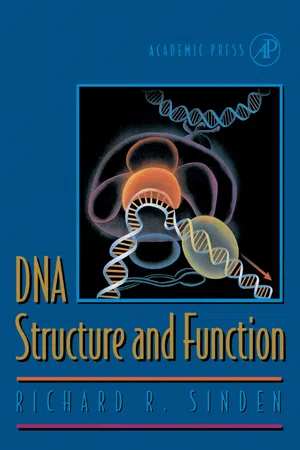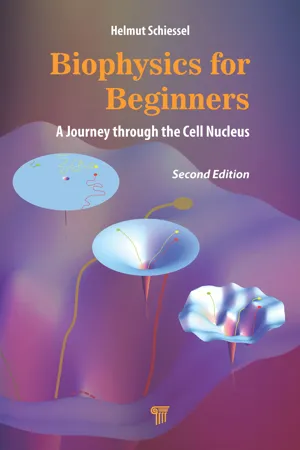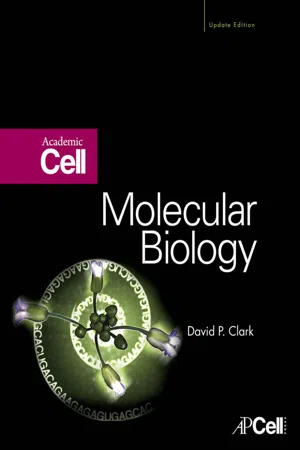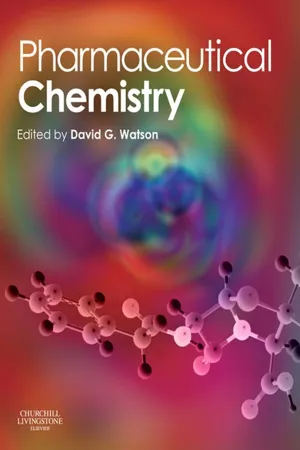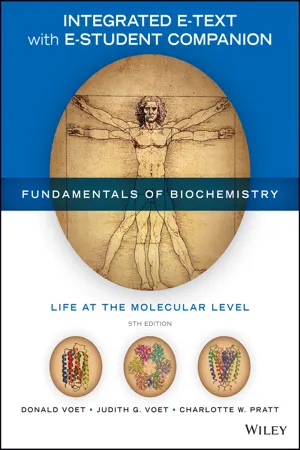Chemistry
Watson and Crick Model of DNA
The Watson and Crick model of DNA, proposed in 1953, is a double helix structure consisting of two strands that are twisted around each other. This model elucidated the mechanism of DNA replication and provided a foundation for understanding genetic inheritance. It also revealed the complementary base pairing of adenine with thymine and guanine with cytosine, which is crucial for the accurate transmission of genetic information.
Written by Perlego with AI-assistance
Related key terms
Related key terms
1 of 4
Related key terms
1 of 3
9 Key excerpts on "Watson and Crick Model of DNA"
- eBook - ePub
- Richard R. Sinden(Author)
- 2012(Publication Date)
- Academic Press(Publisher)
It is significant biologically that the genetic information exists as a double-stranded B-form DNA molecule. First, the two complementary strands provide templates that can be copied by DNA polymerase, producing two exact copies of the genetic information. Second, the double-stranded structure is also of critical importance when either strand is damaged by genotoxic chemicals or ionizing or ultraviolet irradiation. By having two complementary copies of the genetic information, the undamaged strand can serve as a template for repair of the damaged strand. Third, the B-form helix is designed to protect the chemical identity of the genetic information. Hydrogen bonding, base stacking interactions, and hydration of the helix stabilize and chemically insulate the Watson–Crick informational coding surfaces from the environment. Female germ-line cells in humans are produced early in development and may exist more than 40 years before fertilization. The accumulation of damages to the genetic information in germ-line cells could not be tolerated. The stability of DNA, aided by its packaging and condensation with proteins, ensures that the genetic information is chemically inert.E. Sequence-Dependent Variation in the Shape of the DNA
A canonical textbook B-form helix is not likely to exist in living organisms because the actual shape of a region of DNA will depend on its base composition, the local sequence environment on either side of the region, and the composition of the cellular milieu. Evidence for local variation in helix parameters has come from the X-ray crystallographic analysis of DNA (Dickerson and Drew, 1981 ; Dickerson, 1983 ). Analysis of the crystal structure of the 12-bp sequence 5′CGCGAATTCGCG3′ showed that the twist angle between adjacent base pairs varied considerably, from 32° to 45°. In addition, not all identical dinucleotides had the same twist angle, which means that adjacent bases or flanking sequence can influence the shape of a dinucleotide. The average twist angles for all possible dinucleotide combinations are shown in Table 1.4 . Since individual twist angles are different, the actual helical repeat and therefore the exact shape of a 10-bp helical turn of DNA can vary considerably. Since each base pair of a helical turn could be any of the four bases (considering one strand) and since there are nine dinucleotides per helical turn, there are 262,144 (49 ) possible variations in helix structure for a 10-bp piece of DNA. This calculation considers only the dinucleotide twist angles shown in Table 1.4 - eBook - ePub
- Michael Fry(Author)
- 2016(Publication Date)
- Academic Press(Publisher)
(4) The bases were placed at the center of the helix whereas the phosphates faced outward. (5) Hydrogen bonds held together the helix by pairing adenine with thymidine and guanine with cytosine. In their model, Watson and Crick specified two hydrogen bonds per each of the two base pairs (Fig. 5.28C). It was only later that Pauling and Corey pointed out that guanine was linked to cytosine by three hydrogen bonds (see Section 5.7.1). Although a broader discussion of the biological implications of the model was postponed for the next paper, Crick had added at the end of the first article a sentence that became in time the most famous understated comment in the annals of molecular biology 1 : It has not escaped our notice that the specific pairing we have postulated suggests a copying mechanism for the genetic material. The Wilkins, Stokes, and Wilson Paper 139 These King’s College investigators presented experimental results and made the following main points: (1) The X-ray diffraction of paracrystalline (fiber) DNA suggested “a helical structure with axis parallel to fiber length.” (2) Their results were “not in conflict” with the double helix model that Watson and Crick proposed in their adjoining paper. (3) DNA from E. coli, sperm, T2 bacteriophage and an active “transforming principle” (source unspecified), all yielded roughly similar X-ray diffraction patterns, suggesting a universality of the structure of DNA. The Franklin and Gosling Paper 137 Franklin and Gosling presented in the article their famous “photo 51” of B-form DNA. This and additional experimental data led to the following major conclusions: (1) Considering the X-ray diffraction pattern of B-form DNA, they stated that: “a helical structure is highly probable.” Notably, however, Franklin and Gosling did not suggest at that point that the helix was double-stranded - eBook - ePub
Biophysics for Beginners
A Journey through the Cell Nucleus
- Helmut Schiessel(Author)
- 2021(Publication Date)
- Jenny Stanford Publishing(Publisher)
Fig. 4.4 . Both are purine-pyrimidine pairs and therefore the resulting two structures are approximately the same size. The specific base pairing explained the mysterious Chargaff’s rules: For any given DNA sample, the amount of A equals the amount of T and the amount of C equals the amount of G.Figure 4.4Once the base pairing was found, the road was paved for 1953’s great discovery byWatson and Crick: the DNA double helix.It was then quite straightforward for Watson and Crick to build a ball-stick model of a double helix with the base pairs forming a regular stack in the middle and the backbones facing the water at the outside (see Fig. 4.4 ). The model was published in 1953 in the journal Nature (Watson and Crick, 1953 ). Watson and Crick did not speak about biological implications, except in the last sentence: “It has not escaped our notice that the specific pairing we have postulated immediately suggests a possible copying mechanism for the genetic material.”4.2 DNA on the Base Pair LevelIn the previous section we presented the general ideas that led to the discovery of the DNA double helix. In this section we provide a more detailed discussion of possible helix geometries. As we shall see, there are various possibilities. We also discuss how the underlying base pair sequence affects the mechanical properties of such helices. In the first subsection we present a geometric picture which provides useful insights into the structure and mechanical properties of the DNA double helix. However, the approach has its limits: Even though there is nothing wrong with it, some of the experimental observations, e.g., the sequence preferences of nucleosomes which contain strongly bent DNA, go against our intuition. This requires a quantitative approach which is described in the second subsection. - eBook - ePub
- David P. Clark(Author)
- 2009(Publication Date)
- Academic Cell(Publisher)
Fig. 3.08 ) in 1953.In 2003 the Double Helix celebrated its 50th anniversary. In Great Britain, the Royal Mail issued a set of five commemorative stamps illustrating the double helix together with some of the technological advances that followed, such as comparative genomics and genetic engineering. In addition, the Royal Mint issued a £2 coin depicting the DNA double helix itself (Fig. 3.09 ).Each base pair consists of one larger purine base paired with a smaller pyrimidine base. So, although the bases themselves differ in size, all of the allowed base pairs are the same width, providing for a uniform width of the helix. The A-T base pair has two hydrogen bonds and the G-C base pair is held together by three, as shown in Figure 3.10 . Before the hydrogen bonds form and the bases pair off, the shared hydrogen atom is found attached to one or the other of the two bases (shown by the complete lines in Fig. 3.10 ). During base pairing , this hydrogen also bonds to an atom of the second base (shown by the dashed lines).Although RNA is normally single-stranded, many RNA molecules fold up, giving double-stranded regions. In addition, a strand of RNA may be found paired with one of DNA under some circumstances. Furthermore, the genome of certain viruses consists of double-stranded RNA (see Ch. 17 ). In all of these cases, the uracil in RNA will base pair with adenine. Thus the base-pairing properties of the uracil found in RNA are identical to those of the thymine of DNA.Complementary Strands Reveal the Secret of Heredity
If one of the bases in a base pair of double stranded DNA is known, then the other can be deduced. If one strand has an A, then the other will have a T, and vice versa. Similarly, G is always paired with C. This is termed complementary base pairing. The significance is that if the base sequence of either one of the strands of a DNA molecule is known, the sequence of the other strand can be deduced. Such mutually deducible sequences are known as complementary sequences . It is this complementary nature of a DNA double helix that allows genetic information to be inherited. Upon cell division, each daughter cell must receive a copy of the parental genome. This requires accurate duplication or replication of the DNA (Fig. 3.11 ). This is achieved by separating the two strands of DNA and using complementary base pairing to make a new partner for each original strand (see Ch. 5 - eBook - ePub
- Alexander Vologodskii(Author)
- 2017(Publication Date)
- CRC Press(Publisher)
viz ., the duplication of genetic information. No biological structure decoded before or after that momentous discovery proved nearly so revealing of the molecular functioning mechanisms.FIGURE 2 . Complementary base pairs. On turning around the pseudosymmetry axis that passes between pairs, the conds N9-C1′ and N1-C1′ trade places.FIGURE 3 . Anti and syn conformations of purine (A) and pyrimidine (B).A three-dimensional model of the double helix (B-form) is shown in Figure 4 .3 The bases in this structure are inside the helix, while sugar-phosphate chains are outside, running in opposite directions. Thus, the double helix, unlike a single strand, does not have a structurally defined direction. The bases, one from each strand, form pairs linked by hydrogen bonds. Significantly, only two types of pairs, AT and GC, are possible in a regular double helix. These pairs have the same geometry with regard to their bonds to the sugars. Besides, their symmetry lane passes through the helix axis (see Figure 2 ). Therefore, they are readily inscribed in the regular double helix structure. These pairs are called Watson-Crick, or complementary, pairs because the two bases complement each other in forming the characteristic pair geometry. The requirement that the bases within a pair be complementary is the reason why the sequence of one strand fully defines the sequence of the other strand.FIGURE 4 . Skeleton model of B-DNA double helix. (From Schlick, T., et al., Theoretical Biochemistry and Molecular Physics, Volume 1: DNA , Adenine Press, Schenectady, NY, 1980. With permission.).The base pairs are situated inside the helix and cling tightly to each other, forming a pile. That is why they have almost no contact with water molecules, and their accessibility to chemical reagents is severely limited. This fact is widely used in studying various disturbances of the regular DNA structure. - eBook - ePub
- David G. Watson(Author)
- 2011(Publication Date)
- Churchill Livingstone(Publisher)
Chapter 7 DNA structure and its importance to drug actionSimon P. MackayChapter contentsIntroduction 131The structural components of DNA – DNA primary structure 132DNA bases 132Pyrimidine bases 132Purine bases 133Deoxynucleosides 133Deoxynucleotides 133Complementary hydrogen bonding between DNA strands 134DNA secondary structure – the double helix 138Conformation of the deoxyribose sugar 138Conformation of the base with respect to the sugar 138The phosphodiester bonds 139Base pair stacking 139Why a helix, not a ladder? 140Helical grooves – major and minor 140Helical repeat/pitch 141A-DNA 141RNA 142Nucleic acid processing 143Nucleic acid processing enzyme targets for drug action 144The origins of torsional strain in DNA 145Introduction
The elucidation of the structure of deoxyribonucleic acid (DNA) in 1953 by James Watson and Frances Crick was one of the major scientific events of the last century. The recent unravelling of the human genome would not have been possible today without Watson and Crick’s fundamental descriptions of the role of complementary base pairing and the organisation of the component deoxynucleotides into a double helical structure. Since Rosalind Franklin’s groundbreaking research using X-ray crystallography to define two general forms of helical DNA, a whole variety of experimental techniques have shown that the structure of DNA is far more complex than originally proposed. Not only are there different morphological states (e.g. A, B, Z), the structure is also sequence dependent, where the order of the nucleotides can influence the three-dimensional shape in different regions of the helix. Such variations in structure according to sequence are fundamental to the function of DNA and its interactions with the many different proteins that seek to influence its role in cellular biochemistry. It is not the purpose of this chapter to discuss in depth the minutiae of DNA structural variations; there is already a wealth of literature available which describes these phenomena. Here, we provide the basics of DNA structure and function in order to lay foundations for later chapters where DNA plays a part in the pharmacological action of specific drugs. These work through a variety of chemical mechanisms including DNA cleavage and cross-linking, or by reversible association, usually by intercalation or binding in one of the DNA grooves. It is fair to say that a number of drugs whose cellular target is DNA were in use before the structure of DNA had been solved, or even before it was recognised as the repository of the genetic code, e.g. - eBook - ePub
- Hugh Fletcher, Ivor Hickey(Authors)
- 2012(Publication Date)
- Garland Science(Publisher)
The space between the polynucleotides is such that a two-ring purine interacts with a single-ring pyrimidine. Thus, thymine always interacts with adenine and guanine with cytosine. Hydrogen bonds form between the bases and help to stabilize the interaction. Two bonds form between A and T, and three between G and C. Thus, G-C bonds are stronger than A-T bonds. The way in which the bases form pairs between the two DNA strands is known as complementary base pairing and is of fundamental importance (Figure 6). Combinations other than G-C and A-T do not work because they are too large or too small to fit inside the helix or they do not align correctly to allow hydrogen-bond formation. Because G must always bond to C and A to T, the sequences of the two strands are related to each other and are said to be complementary with the sequence of one strand predicting and determin ing the sequence of the other. This means that one strand can be used to replicate the other. This is a vital mechanism for retaining genetic information and passing it on to other cells following cell division. Complementary base pairing is also essential for the expression of genetic information and is central to the way DNA sequences are transcribed into mRNA and translated into protein. Figure 6. Complementary base pairing. Hydrogen bonds are shown as dashed lines. The double helix is stabilized by hydrogen bonds between the base pairs. These can be disrupted by heat and some chemicals. This results in separation of the double helix into two strands and the molecule is said to be denatured. In cells, enzymes can separate the strands of the double helix for the purposes of copying the DNA and for expression of the genetic information. RNA structure The structure of RNA is similar to that of DNA but a number of important differences exist. In RNA, ribose replaces 2′-deoxyribose and the base thymine is replaced by another base, uracil, which can also base pair with adenine (Figure 7) - eBook - ePub
Fundamentals of Biochemistry, Integrated E-Text with E-Student Companion
Life at the Molecular Level
- Donald Voet, Judith G. Voet, Charlotte W. Pratt(Authors)
- 2017(Publication Date)
- Wiley(Publisher)
- The planes of the nucleotide bases, which form hydrogen-bonded pairs, are nearly perpendicular to the helix axis. In B-DNA, the bases occupy the core of the helix while the sugar–phosphate backbones wind around the outside, forming the major and minor grooves. Only the edges of the base pairs are exposed to solvent.
- Each base pair has approximately the same width (
Fig. 24-1), which accounts for the near-perfect symmetry of the DNA molecule, regardless of base composition. A ⋅ T and G ⋅ C base pairs are interchangeable: They can replace each other in the double helix without altering the positions of the sugar–phosphate backbones' C1′ atoms. Likewise, the partners of a Watson–Crick base pair can be switched (i.e., by changing a G ⋅ C to a C ⋅ G or an A ⋅ T to a T ⋅ A). In contrast, any other combination of bases would significantly distort the double helix.- The canonical (ideal) B-DNA helix has 10 base pairs (bp) per turn (a helical twist of 36° per bp) and, since the aromatic bases have van der Waals thicknesses of 3.4 Å and are partially stacked on each other, the helix has a pitch (rise per turn) of 34 Å.
The Watson–Crick base pairs. The line joining the C1′ atoms is the same length in both A ⋅ T and G ⋅ C base pairs and makes equal angles with the glycosidic bonds to the bases. This gives DNA a series of pseudo-twofold symmetry axes that pass through the center of each base pair (red line) and are perpendicular to the helix axis. [After Arnott, S., Dover, S.D., and Wonacott, A.J., Acta Cryst. B25, 2196 (1969).]FIG. 24-1Explain why the consistent size of base pairs would simplify the task of storing large amounts of DNA in a cell’s nucleus.Box 1 Pathways of Discovery
Rosalind Franklin and the Structure of DNA
Rosalind Franklin (1920–1958) - eBook - ePub
Genomics in the AWS Cloud
Analyzing Genetic Code Using Amazon Web Services
- Catherine Vacher, David Wall(Authors)
- 2023(Publication Date)
- Wiley(Publisher)
hydrogen bonds (the bases A pair with T, the bases G pair with C), coil around each other, and form the elegant and well-known DNA helix structure.DNA is a convenient and compact way of storing information. It has already been used to store small, compressed MPEG movies and data of up to 200 MB.In living organisms, the long DNA molecule is broken into segments called chromosomes. Species have various numbers of chromosomes: the fruit fly has 8 chromosomes, spinach and slime mold have 12, humans have 46, dogs and chickens have 78, and carp have 100. Bacteria stand apart as they have a single chromosome of circular shape, which is free floating as bacteria do not have a nucleus. The 46 human chromosomes are divided into two sets of 23 chromosomes, with each set inherited from each parent. Our chromosomes are numbered from 1 to 22, with the last two chromosomes, X and Y, determining our sex.Not to be forgotten, each of our cells also contains between 80 and 2,000 small oval structures called mitochondria that produce the energy required for the cell. Mitochondria are thought to be bacteria that have been internalized by the cells of our remote primitive ancestors some 1.45 billion years ago. Each of our mitochondria has its own DNA, which has a circular shape (like in bacteria), unlike our linear chromosomes. We inherit our mitochondrial DNA exclusively from our mother. This allows genealogical researchers to study our maternal lineage many generations ago.The total length of our genome, if we put our chromosomes end to end, would be nearly 2 meters. To fit into the tiny nucleus of each of our cells, our DNA is first wound around proteins called histones and then tightly folded and coiled. This packing complex of DNA and histone is called chromatin. When the chromatin is tightly packed (also called condensed), the DNA cannot be accessed. When a region of DNA needs to be read, the chromatin is unpacked and is said to be open
Index pages curate the most relevant extracts from our library of academic textbooks. They’ve been created using an in-house natural language model (NLM), each adding context and meaning to key research topics.
Explore more topic indexes
Explore more topic indexes
1 of 6
Explore more topic indexes
1 of 4
